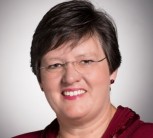South Africans are hungry. That is the harsh reality faced by poor communities that make up more than half of the population. The masses simply aren't eating a diet that is diverse or wholesome enough to get the right amount of nourishment they need.
Half of South Africa's population—some 27 million people—live below the global poverty line. Government grants are often the only means of survival for poor rural communities. However, the grants fall quite short of being able to cover the basic cost of nutritious food.
Maize meal is a staple in poor communities due to its affordability, but it only covers a fraction of a person's nutritional needs. Desperate communities often turn to subsistence farming to bridge the nutritional divide, but a lack of agricultural know-how hampers their progress. The crisis is deepened even further by drought and ongoing climate change.
Source: Stats SA (2015)
Communities need to be able to rely on information that is locally relevant, which directly impacts their subsistence farming efforts. The University of Pretoria’s Institute for Food Nutrition and Wellbeing (IFNuW) is actively working with poor communities to turn the tide on hunger.
IFNuW developed recommendations for poor communities based on what is possible to grow in their areas, while ensuring that the recommended crops met the nutritional needs of the communities. Their goal was to find the most nutritious crops that require the least water. Striking such a balance is key to ensuring that poor rural communities are able to sustain themselves in the long term.
For all the assembled data to amount to meaningful change, it needed to be provided to poor communities in a way that was relevant to them. IFNuW created a series of posters and brochures in partnership with the communities the materials would be serving. Community leaders and agricultural officers would then spread the information to improve the education and farming ability of their people. By making better farming and dietary choices, researchers hope that the nutrition of these communities will improve.
An easy-to-use app has been developed that provides information to communities about the crops that will thrive in their areas. Gathered data is also used to craft recommendations for policymakers, as well as inform the new South African Food Security Information System.
This uplifting research is funded by the Water Research Commission (WRC) and co-funded by Department of Agriculture, Forestry and Fisheries (DAFF) with supplementary funding from National Research Foundation (NRF) and the illustrious Post-Doctoral Fellowship Programme of the University of Pretoria. The University is playing its part in actively improving availability, use and supply of food to provide homegrown solutions for South Africa’s hungry.
According to the Food and Agriculture Organisation (FAO) of the United Nations (UN), food security is “when all people, at all times, have physical and economic access to sufficient, safe and nutritious food to meet their dietary needs and food preferences”.
This can be further broken down into food availability, accessibility, utilisation, and stability of supply.
Food availability refers to supply on the local, national and international scales. Accessibility refers to whether individuals and communities can obtain their food, and is influenced by food price, supply chains, and consumption patterns. Utilisation refers to whether the nutritional value of the food is available to those consuming it, and is influenced by food storage and preparation as well as dietary diversity. Lastly, food stability means that there is a reliable supply of diverse, nutritious food.
Food security is a complex issue even in developed countries, where scientists arestarting to realise that access to sufficient calories does not necessarily mean that a community is food secure. Increasingly, food security means dietary diversity to ensure that an individual gets the nutrients required to live a healthy life.
Prof Sheryl Hendriks of the IFNuW recently published an article describing food insecurity as a continuum between adequate nutritious intake and acute starvation. Between those two extremes are millions of South African’s who suffer from this 'hidden hunger' – they get enough calories to avoid hunger, but their diets lack the nutrients required for children to develop correctly and for adults to be productive.
Source: FAO 2008, The Conversation Africa, Hendriks 2015,
In South Africa, citizens have a right to food, good nutrition and water, according to the SA Constitution. This is addressed in the National Development Plan (NDP), which calls for government, citizens and the private sector to work together to establish a self?reliant local food system.
According to a national survey in 2013, 17% of households in South Africa struggle to access food; this number goes up to 22% in KwaZulu Natal (KZN), South Africa’s hungriest province. In that year, 11% and 34% of households experienced hunger in South Africa and KZN, respectively. Of those, 6% of South African households and 4% of KZN households experienced severely inadequate access to food.
One in four households experience hunger in most months of the year; one in three reported hunger in January. In general, households could afford enough maize meal to feed themselves, thanks largely to social grants.
54% of SA households live on less than R779/month, the official poverty line based on the World Bank figure of US $1.90/day. 37% of South African households do not earn enough to cover their living costs, while 32% of the population are on social grants. Alarmingly, the percentage of households reporting limited access to food increased from 21.5% in 2012 to 23.1% in 2013.
Growth stunting and childhood obesity are two common measures of malnourishment. In South Africa, 26% of children younger than five years are stunted, while 14% of children younger than nine years are obese (body mass index over 30).
Stunting has increased in South Africa since the Millennium Development Goals were put into place, one of only 12 countries where this is the case. In the South African Development Community, it is the only country where this is the case.
The IFNuW’s research paints a similar picture for South Africa’s poorest communities: stunting in children under 5 years old was at 24%. Overall, 15% of children between the age of two and five were over?weight, and boys were generally more undernourished than girls.
One in five (22%) of female caregivers was overweight and 37% were classified as obese, which is in line with national statistics for this indicator of poverty.
Source: SAHRC, NPC 2012, Statistics SA, Hendriks et al. (2014)
A common misconception is that South African rural communities do not grow their own food. This is influenced by local conditions, particularly how much water is available, but in general not true.
The IFNuW found that a surprising number of households grew their own food in the Eastern Cape, KwaZulu?Natal and Limpopo sites, and those households had much more diverse diets than those that grew no food. Greater dietary diversity was even more likely when considering households that irrigated their crops.
Home gardening was linked to eating more white roots and tubers, dark green leafy vegetables, orange?coloured fruit and other fruit (see the table on the top right for the full list of food types). Those communities involved in communal garden projects ate more dark green leafy vegetables and other vegetables than those that relied on individual farming.
Researchers began by collating questions from a number of household surveys, working with Statistics South Africa to compile a sort of survey of surveys. The surveys questions were digitised in the form of an Android app which collected information and recorded it directly to a spreadsheet for immediate access.
The app was developed by Corne van der Merwe, an MSc student working on digital tools to address food security in SA.
At each site, trained enumerators used tablets to record survey data on diet, health indicators and farming in the community. Researchers wanted a better picture of how these communities feed themselves, and how reliant they are on rain?fed and irrigated agriculture to do this. The survey also recorded income and investigated whether communities had access to diverse food groups.
Surveys were conducted in both winter and summer in order to measure differences in seasonal agriculture.
From the data collected during the survey, researchers created recommendations for which crops to plant in each community, based on the available water and the dietary needs of the community. These recommendations took the form of graphic posters and brochures that made them easy for community members and extension officers to understand.
Recommendations were usually on the basis of one or more specific nutrient that the crop can provide. Several species were recommended as multi?purpose crops, as in the case of cowpea, a traditional crop that can provide grains and leafy greens as well as animal feed. Researchers also took into account the nutritional water productivity of various crops, which is a measure of the nutritional value of a crop in relation to the water required to grow it.
Overall, IFNuW found that good diet was clearly linked to agriculture, which is an encouraging sign. However, the findings also clearly showed that diverse diets are not common in the poor rural communities of South Africa, with sobering consequences for socioeconomic development in these areas. Further, with the added burden of the current drought, it may not always be possible for communities to improve their nutritional intake through subsistence agriculture.
Another major product of the project is the Smart Grow app currently in development at the University of Pretoria. Developed by MSc student Corne van der Merwe, Smart Grow is an electronic resource that makes the data and recommendations represented accessible via smartphone. While still in progress, the current version can be downloaded here, along with installation instructions.
Finally, the findings of this project will provide input on useful indicators for the SA National Food Security Information System, currently being developed by the Department of Agriculture, Forestry and Fisheries (DAFF). One of the researchers on the project, Dr Mjabuliseni Ngidi, is now working for the DAFF on this project.
The LIMA Rural Development Foundation facilitated interactions between researchers and community members during the study. LIMA provides training, infrastructure and economic development to help rural communities around South Africa rise above poverty and hunger.
By working with LIMA, researchers ensured easy access to the research sites and set the stage to contribute to the long?term development of these communities.
In conjunction with LIMA, researchers trained eight enumerators at each site – members of the community with at least a Matric education were recruited and trained in research methodology, anthropometry techniques and how to use the tablets to record data.
Receiving community feedback was important to ensure that the research interventions proposed by researchers were realistic and applicable to the situation on the ground. This was achieved through validation workshops, where 30?40 community members, farmers, community garden managers and extension officers were asked for input. By working with LIMA, researchers ensured easy access to the research sites and set the stage to contribute to the long?term development of these communities.
Translators presented the findings in the relevant local language to maximise understanding in the communities. The communities provided information on whether the information in the brochures was correct and accurate, whether the communities disagreed with the any of the findings for reasons of taste or experience, and what the communities thought research priorities should be going forward.
In general, the response to the research was positive – community members appreciated that researchers took the time and effort to communicate their results. Many of these communities have been and are visited regularly by all kinds of researchers, but few if ever return to give the communities feedback on their work, so that really sets the IFNuW team apart.
Communities were well aware of the unhealthy nature of modern store?bought foods. The most common objection from thecommunities was that a diverse diet is not affordable, despite suggestions in the data to the contrary.
Notably, local knowledge of agricultural conditions often disagreed with researchers’ ideas of what could be grown in a particular area.
Lack of water was the major reason cited by communities about why this was the case. The researchers’ information was based on long?standing agronomic data, suggesting that the growing conditions have changed drastically in the last few decades. This idea was corroborated by community members, who said that many crops that could be grown in the past no longer grow due to lack of water or a changing climate.
When asked what researchers should be focussing on, communities invariably answered that future research should focus on water use and adaptive farming methods that can help them deal with climate change.
At the University of Pretoria, the solutions to change the world can be found in the research we do today; that’s how we are actively improving availability, use and supply of food to provide homegrown solutions for South Africa’s hungry.
Make today matter
Audio Clip: Mrs Jwacu from Lusikisiki in the Eastern Cape talks via a translator about how agriculture has changed there, due to modern life and the changing climate. Courtesy of Angela McIntyre.
Brochures: These are the brochures distributed to rural communities.
Stories on the web: https://theconversation.com/food-insecurity-is-more-than-just-severe-hunger-46752
Why a diverse diet is crucial for rural South Africans by Sheryl L Hendriks and Angela McIntyre
Limited food options take their toll on the health of South Africa’s rural poor by Angela McIntyre
For more information, please visit our website.
Prof Sheryl Hendriks
August 2, 2016

Professor Sheryl Hendriks completed her undergraduate studies, honours, master’s and PhD at the former University of Natal, where she also taught until joining the University of Pretoria (UP) in 2010.
Moving to UP expanded and enhanced her research, not only because of the geographic proximity to government but because it allowed her to network with colleagues at UP, in Africa and internationally. Prof Hendriks says that the University’s reputation as well as UP management’s support of transdisciplinary research have been invaluable in advancing her research profile, impact and reach.
Research in food security policymaking is essential to achieve the Sustainable Development Goals (SDGs) and advance development. Understanding the causes, outcomes and impact of policy decisions related to a range of sectors (agriculture, health, trade, welfare etc.) helps to identify potential policy choices, combinations and directions. Ultimately, these decisions determine the levels of poverty, inequality and food insecurity experienced by households.
Prof Hendriks leads a large research group that explores the emerging field of improving food systems to ensure fairer, healthier diets and sustainability. The group includes postgraduates and colleagues from UP’s Department of Agricultural Economics, Extension and Rural Development in the Faculty of Natural and Agricultural Sciences (NAS), and connects with colleagues in networks across Africa and beyond. Under the RETHINK@NAS initiative ¬– which allows for University-driven community projects that support transformation in all its forms – this group will expand across faculties.
This work was carried out in Prof Hendriks’s role as a member of the United Nations Food Systems Summit (UNFSS) Scientific Group and contributed a significant analysis to guide the group’s 2021 deliberations and plan of work. It will also expand to supporting the country implementation of actions to support the true value of food. The work was inspired by Prof Lawrence Haddad (leader of the UNFSS Action Track on ending hunger) and Prof Joachim von Braun (chair of the UNFSS Scientific Group).
Prof Hendriks says that since 2006, her academic mentor has been Dr Ousmane Badiane, who introduced her to the dynamics of African development and has provided her with countless opportunities to work directly in applying research in practical support to African governments as they seek to achieve food security. “Through my engagement in various think-tanks and policy engagements, I find meaning in life – contributing to decisions that can improve the lives of ordinary people,” she says. “This is a dream come true for me.”
Young people interested in following her field of research need to be passionate about helping others and acutely aware of the bigger picture in development, Prof Hendriks advises. Food security analysis can be attempted only at postgraduate level, she adds, when students have a solid grounding in a relevant field and have developed skills to cope with complex thinking.
When not pursuing research endeavours, Prof Hendriks maintains a rose and herb garden, sews, scrapbooks and walks her dogs.
 Story
Story
University of Pretoria (UP) researchers have found that the antioxidant content of certain types of tea can be likened to that found in recommended portions of fruit and vegetables.
 Infographic
Infographic
Half a cup of black tea, oolong tea or green tea contained the same amount of antioxidants with radical scavenging capabilities (RSC) as that of a 200mg vitamin C tablet.
 Story
Story
Researchers at the University of Pretoria (UP) may have identified the gene that is responsible for diet-related obesity. By exploring the role of the novel gene Slc7a8, they have made a potential breakthrough in current knowledge about the cellular mechanisms that drive fat accumulation. This understanding is crucial in developing effective treatments.
Copyright © University of Pretoria 2025. All rights reserved.
Get Social With Us
Download the UP Mobile App